Flowers & photograph: Huw Morgan
Published 3 April 2021
The hush and the breathing space that comes, now that the leaves are down and the grass has finally slowed, is palpable. In the mild spells between freezes I take this opportunity to square up the holding area by the barns. This is where one day I plan for a greenhouse, but for now it is where I propagate and look after the plants that are waiting for a home. The cold frames which reared the spring seedlings are now packed to the gunnels with plants that need protection from the lethal combination of winter wet and freeze. Auriculas and the Mediterranean herbs are kept on the dry side and the autumn seedlings and cuttings will make a surprising leap forward with this little extra shelter. Out in the open and hunkered together for protection are bulbs to go out in the spring, once I can see exactly where they need to be and that they are the correct varieties, as well as youngsters that are ready and waiting for areas that are not quite prepared in which to set them loose. This backlog is a perpetual conundrum, but I have a three-year rule so that the holding ground avoids becoming a corner of shame. If they cannot be found a place, they will be put out on the lane with a sign saying, “Please help yourself”. Very few are left unclaimed and I trust they find good and unplanned for new homes.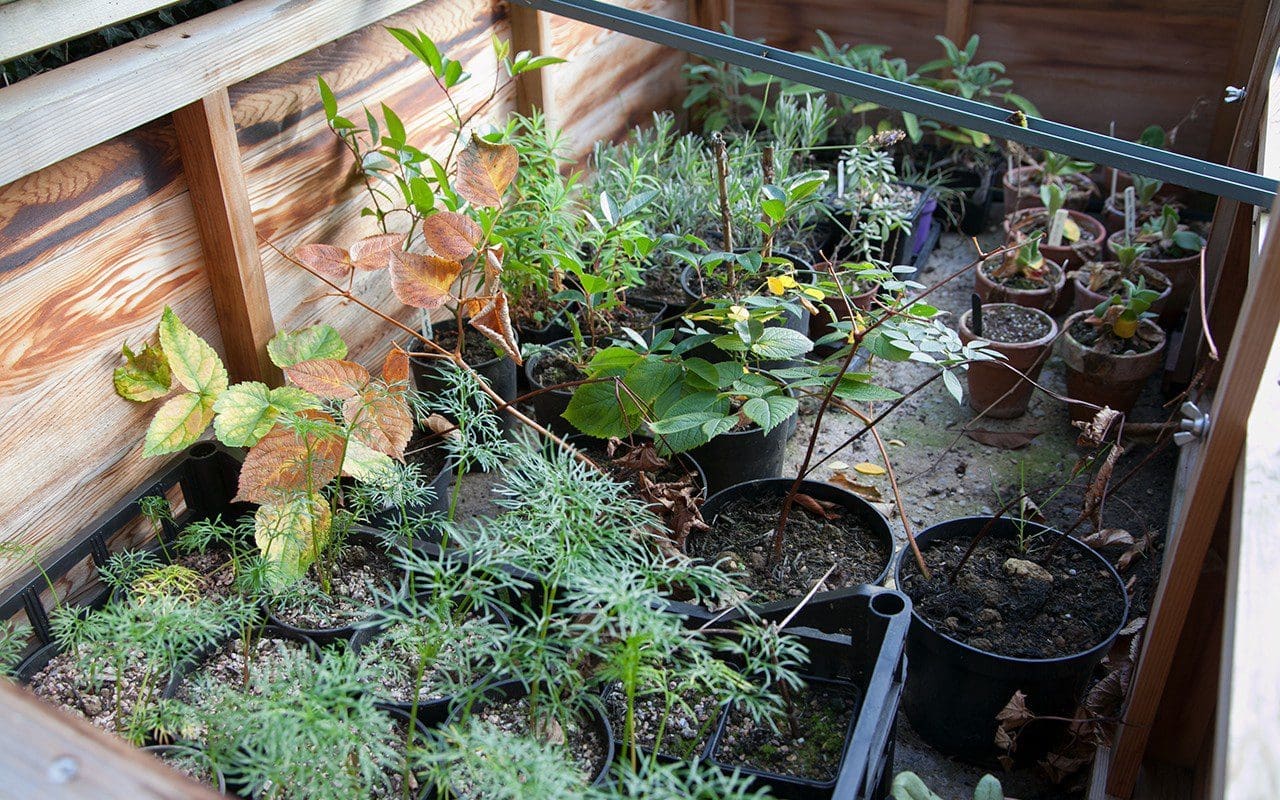 One of the cold frames
One of the cold frames
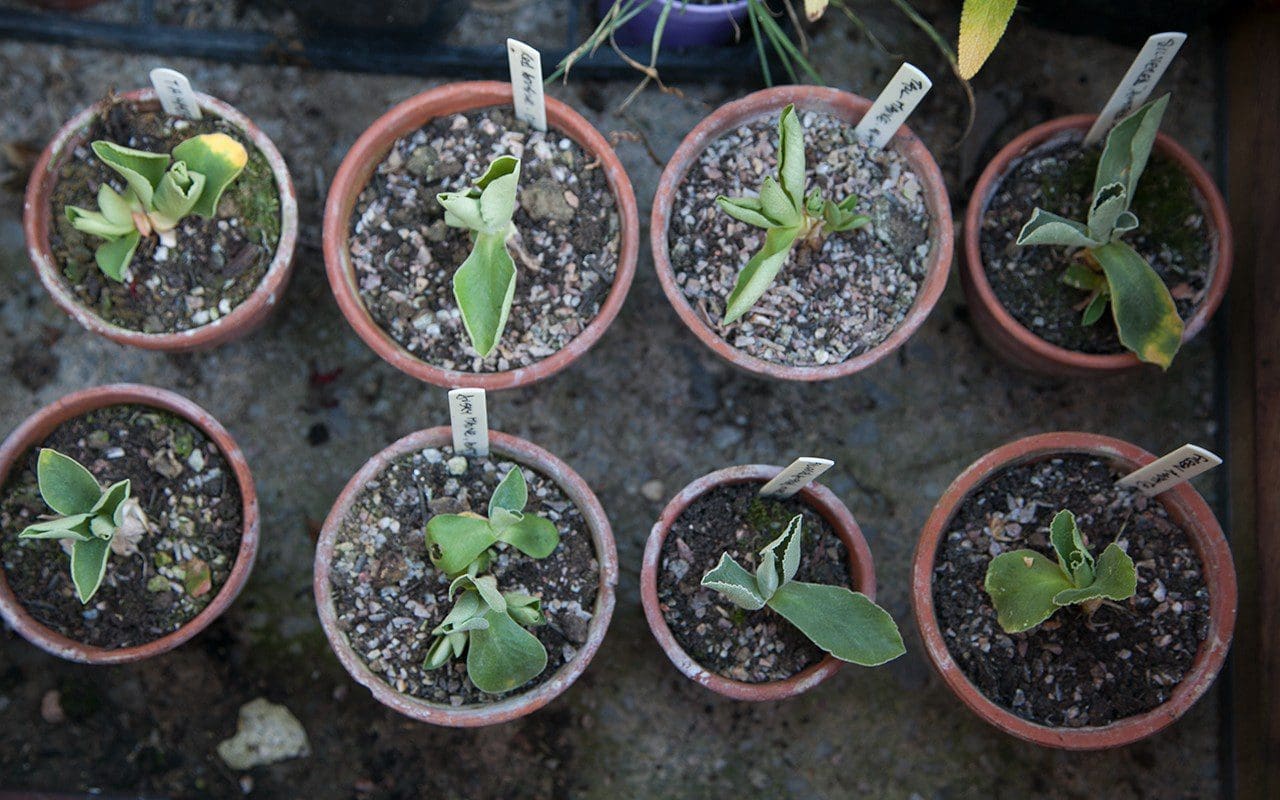 Auriculas
Auriculas
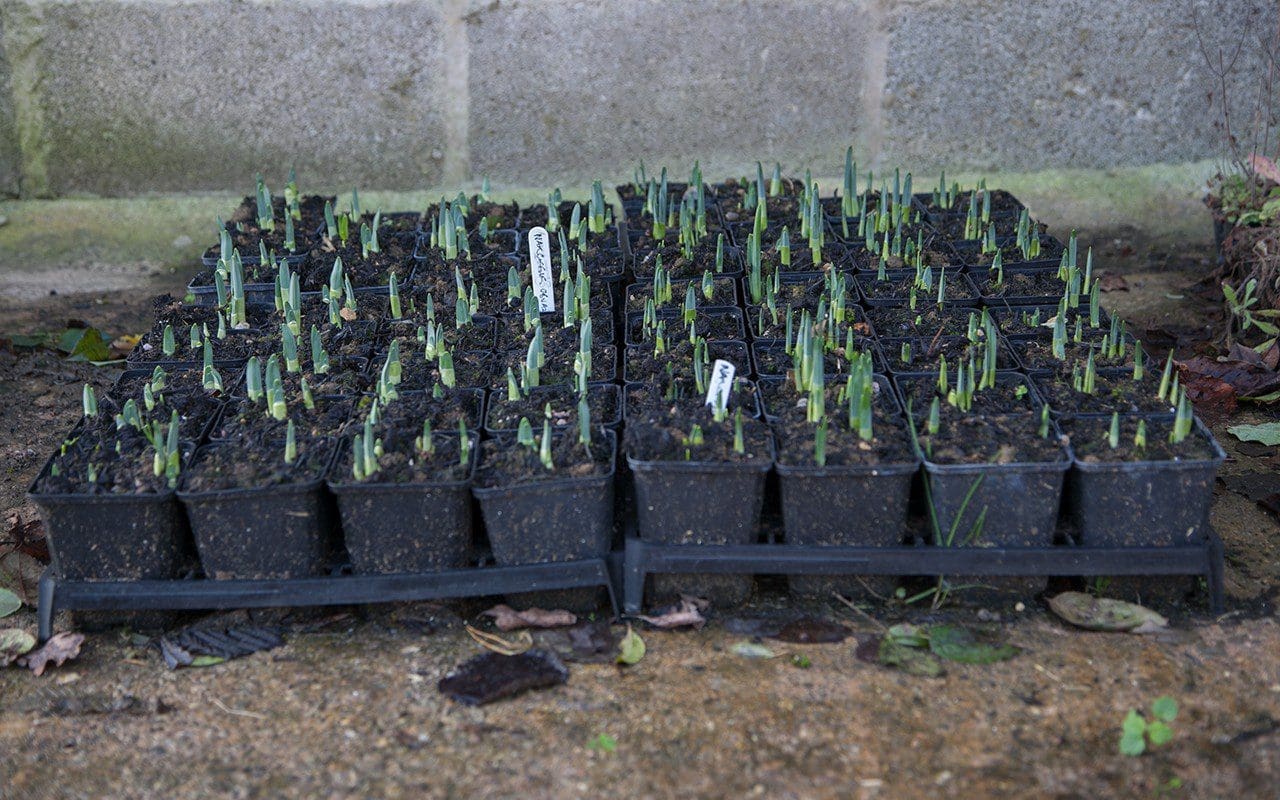 Narcissus
It is always good to start the year by planting trees and I am happy to use this window in the season to liberate the chosen few so that by the end of the holidays I am organised and ready for a new year. If they have been potted on annually, the woody seedlings are just about perfect at the end of a three-year period. This year, the first to be liberated will be the small-fruited form of Malus hupehensis, which were grown from the fruit of the single plant I have up in the blossom wood and are ready now to make the leap into open ground.
The seedlings are part of the learning curve that is illustrated in the trees they are going to join and in part replace. Destined for our highest ridge above the house, I plan for a huddle of berrying trees that will burst a cloud of blossom against the skyline in the spring. Three plants will join the hawthorn that were frayed out into the field from the Blossom Wood and the fourth will replace an ailing Malus transitoria. I have staggered this small, amber-fruited crab up the slope to meet the Blossom Wood on the high ground, but I have obviously pushed this Chinese species to the limit, for the higher up the slope they go the weaker they become, despite the fact that it is reputed to be resistant to drought and cold. With barely a finger’s worth of growth in the five summers they have been there, compared to several feet on those lower down the slope, they have demonstrated exactly what they require in the time they have been there.
I have dutifully mulched and watered and fed, but five years is quite long enough to know if a plant doesn’t like you, and so I feel justified in making the change. As I mature as a gardener, the question of time becomes more acute. I want to spend it wisely and use my energy well which, when you are investing years in trees, is important. That said, I am happy to plant young and though the saplings are barely up to my knee, they have the vigour of youth and will jump away with the below-ground growing time of winter ahead of them. The Malus hupehensis further up the slope has shown me that it has the stamina its cousin doesn’t and it is a good maxim that if you fail with one species, try another before giving up entirely.
Narcissus
It is always good to start the year by planting trees and I am happy to use this window in the season to liberate the chosen few so that by the end of the holidays I am organised and ready for a new year. If they have been potted on annually, the woody seedlings are just about perfect at the end of a three-year period. This year, the first to be liberated will be the small-fruited form of Malus hupehensis, which were grown from the fruit of the single plant I have up in the blossom wood and are ready now to make the leap into open ground.
The seedlings are part of the learning curve that is illustrated in the trees they are going to join and in part replace. Destined for our highest ridge above the house, I plan for a huddle of berrying trees that will burst a cloud of blossom against the skyline in the spring. Three plants will join the hawthorn that were frayed out into the field from the Blossom Wood and the fourth will replace an ailing Malus transitoria. I have staggered this small, amber-fruited crab up the slope to meet the Blossom Wood on the high ground, but I have obviously pushed this Chinese species to the limit, for the higher up the slope they go the weaker they become, despite the fact that it is reputed to be resistant to drought and cold. With barely a finger’s worth of growth in the five summers they have been there, compared to several feet on those lower down the slope, they have demonstrated exactly what they require in the time they have been there.
I have dutifully mulched and watered and fed, but five years is quite long enough to know if a plant doesn’t like you, and so I feel justified in making the change. As I mature as a gardener, the question of time becomes more acute. I want to spend it wisely and use my energy well which, when you are investing years in trees, is important. That said, I am happy to plant young and though the saplings are barely up to my knee, they have the vigour of youth and will jump away with the below-ground growing time of winter ahead of them. The Malus hupehensis further up the slope has shown me that it has the stamina its cousin doesn’t and it is a good maxim that if you fail with one species, try another before giving up entirely.
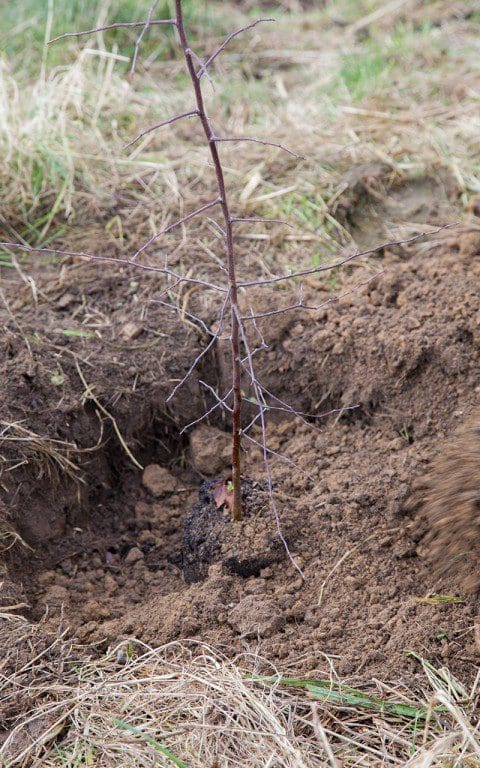
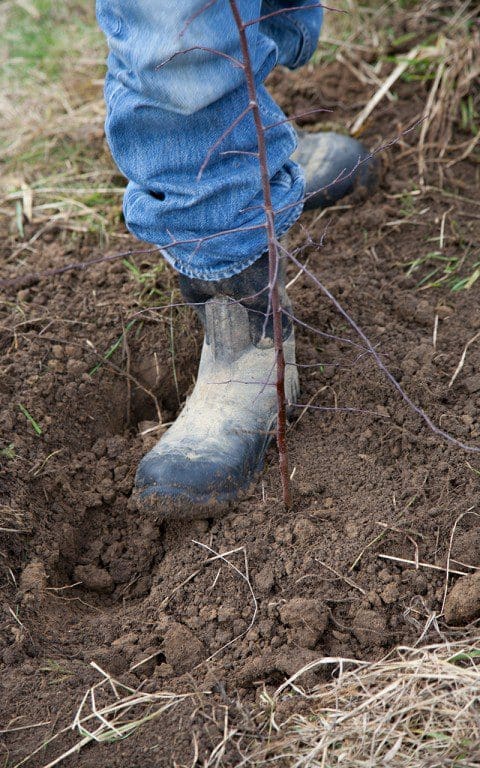 Planting a seedling Malus hupehensis
When planting woody material, and trees in particular, I prefer not to include organic matter to avoid an enriched planting hole from which the young tree prefers not to venture. Instead, the top sod, where the best soil lies, is upturned into the bottom of the hole where, by spring, it will have rotted down to provide the young roots with a good layer of loam. The roots of the young trees are given a sprinkling of mycchorhizal fungi to help in their establishment and from here they can make an easy way out into the surrounding ground. If I am to add compost, it will be as a mulch to keep the moisture in and the weeds down, and, in time, the worms will pull it to ground. Three years of clear ground around the base of a new tree is usually enough to give it the chance to get the upper hand and for the competition not to stunt growth. Growth which, in the case of my young Malus, and now that they have been liberated from the holding ground, will have nothing to hold it back come spring.
Words: Dan Pearson / Photographs: Huw Morgan
Published 6 January 2018
Planting a seedling Malus hupehensis
When planting woody material, and trees in particular, I prefer not to include organic matter to avoid an enriched planting hole from which the young tree prefers not to venture. Instead, the top sod, where the best soil lies, is upturned into the bottom of the hole where, by spring, it will have rotted down to provide the young roots with a good layer of loam. The roots of the young trees are given a sprinkling of mycchorhizal fungi to help in their establishment and from here they can make an easy way out into the surrounding ground. If I am to add compost, it will be as a mulch to keep the moisture in and the weeds down, and, in time, the worms will pull it to ground. Three years of clear ground around the base of a new tree is usually enough to give it the chance to get the upper hand and for the competition not to stunt growth. Growth which, in the case of my young Malus, and now that they have been liberated from the holding ground, will have nothing to hold it back come spring.
Words: Dan Pearson / Photographs: Huw Morgan
Published 6 January 2018 Yellow breaks with winter. Soft catkins streaming in the hazel. Brightly gold and blinking celandines studding the sunny banks. They are shiny and light reflecting and open with spring sunshine. As strong as any colour we have seen for weeks and welcome for it.
There is more to come, and in rapid succession, now that spring is with us. The first primroses in the hollows and dandelions pressed tight in grass that is rapidly flushing. Daffodils in their hosts, pumping up the volume and forsythia, of course, at which point I begin to question the colour, for yellow has to be handled carefully.
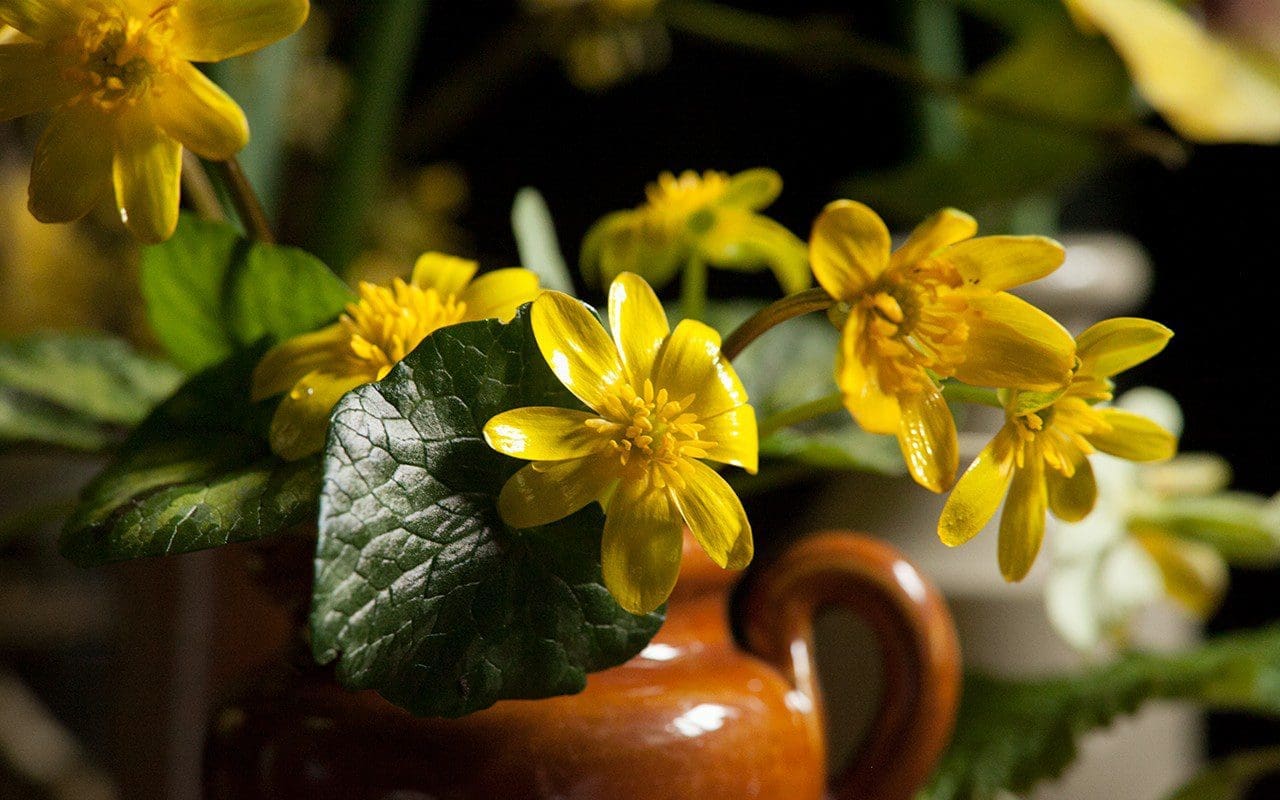 Lesser Celandine – Ranunculus ficaria
Lesser Celandine – Ranunculus ficaria
In all my years of designing it is always yellow that clients most often have difficulty with. ‘I really don’t like it’. ‘I don’t want to see it in the garden’. ‘Only in very small amounts’. Strong language which points to the fact that it prompts a reaction. Colour theory suggests the yellow wavelength is relatively long and essentially stimulating. The stimulus being emotional and one that is optimistic, making it the strongest colour psychologically. Yellow is said to be a colour of confidence, self-esteem and emotional strength. It is a colour that is both friendly and creative, but too much of it, or the wrong shade, can make you queasy, depressed or even turn you mad.
Whether I entirely believe in the thinking is a moot point, but I have found it to be true that yellow is a positive force when used judiciously. My first border as a teenager was yellow. I experimented with quantity and quality and by contrasting it with magenta and purple, it’s opposites. Today I weave it throughout the garden, using it for its ability to break with melancholy; a flash of Welsh poppy amongst ferns or a carefully selected greenish-yellow hellebore lighting a shaded corner.
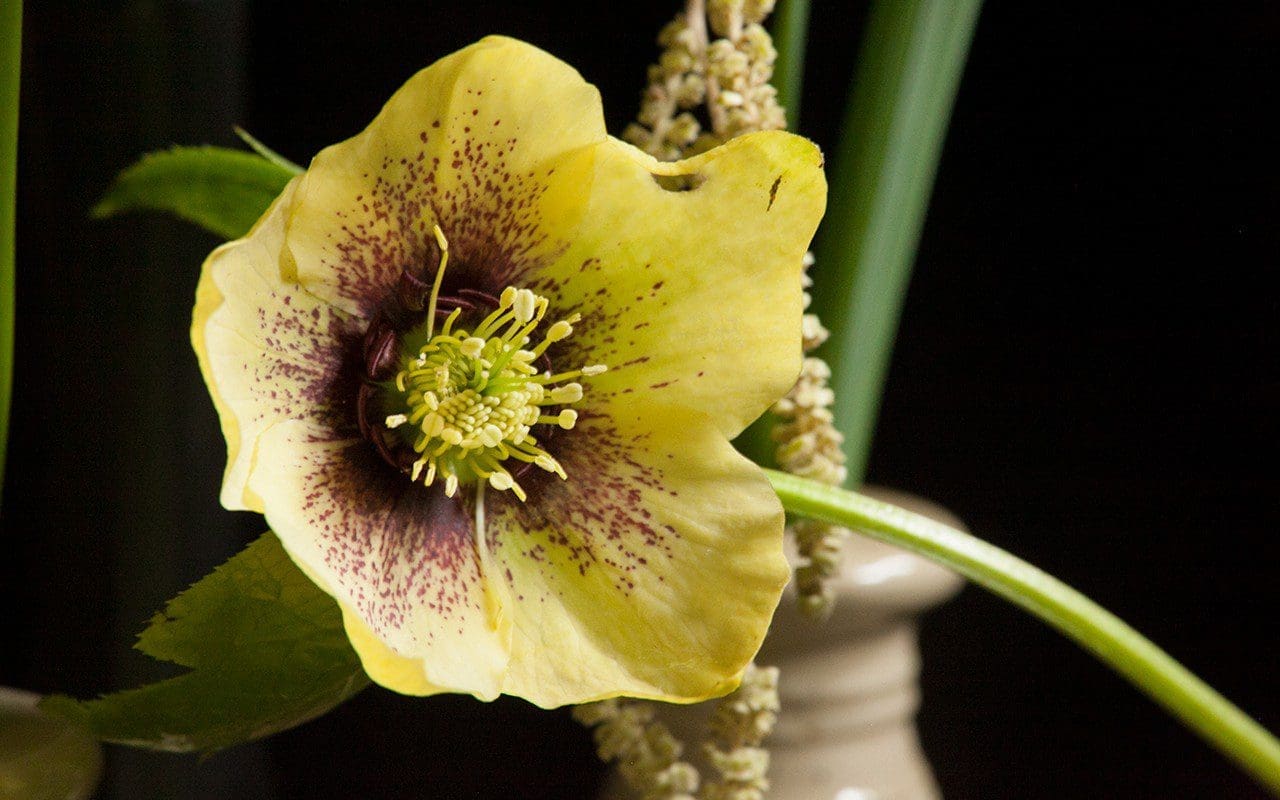 Helleborus x hybridus Ashwood Selection Primrose Shades Spotted
Helleborus x hybridus Ashwood Selection Primrose Shades Spotted
I remember talking to the textile designer, Susan Collier, about the use of yellow in her garden in Stockwell. She had repeated the tall, sulphur-yellow Thalictrum flavum ssp. glaucum throughout the planting and explained how she used it to draw the eye through the garden. ‘Yellow in textile design is extraordinarily persistent. It is noisy, but it lifts the heart. It causes the eye to wander, as the eye always returns to yellow.’
At this time of year, I am happy to see it, but prefer yellow in dashes and dots and smatterings. I will use Cornus mas, the Cornelian cherry, rather than forsythia, and have planted a little grove that will arch over the ditch in time and mingle with a stand of hazel. The fattening buds broke a fortnight ago, just as the hazel was losing its freshness. Ultimately, over time, my widely spaced shrubs will grow to the size of a hawthorn, the cadmium yellow flowers, more stamen than petal, creating a spangled cage of colour, rather than the airless weight of gold you get with forsythia.
We have started splitting the primroses along the ditch too. I hope they will colonise the ground beneath the Cornus mas. I have a hundred of the Tenby daffodil, our native Narcissus obvallaris, to scatter amongst them. The flowers are gold, but they are small and nicely proportioned. Used in small quantity and widely spaced to avoid an obvious flare, they will bring the yellow of the cornus to earth.
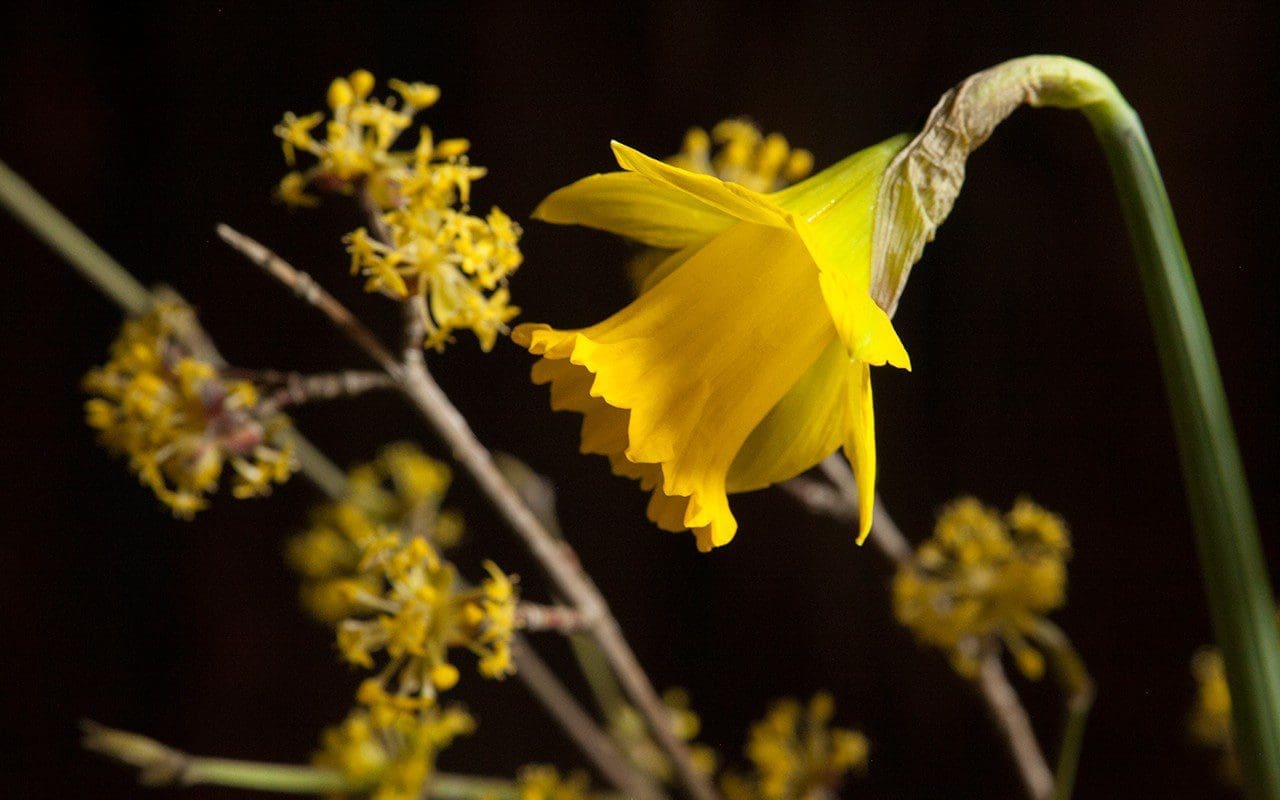 Narcissus obvallaris with Cornus mas (Cornelian cherry)
Narcissus obvallaris with Cornus mas (Cornelian cherry)
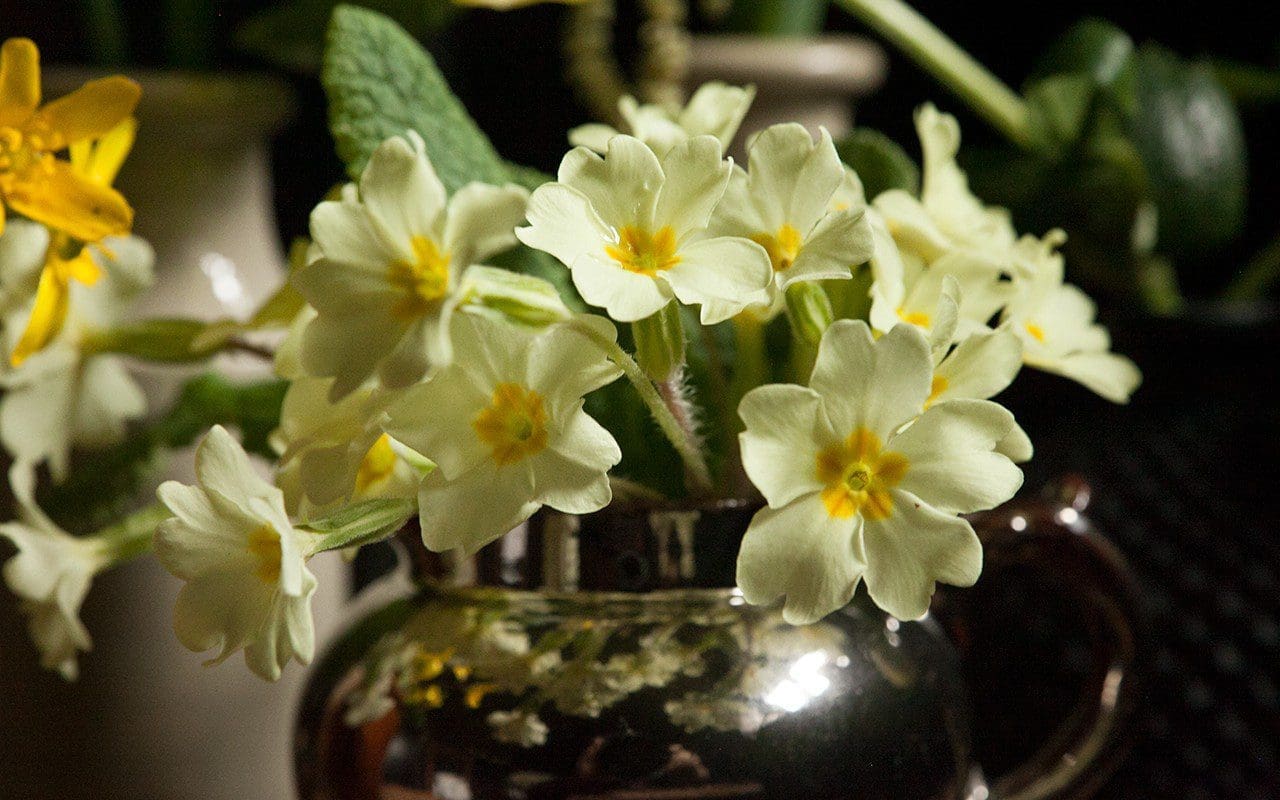 Primrose – Primula vulgaris
Primrose – Primula vulgaris
After several years of experimenting with narcissus, I have found that they are always best when used lightly and with the stronger yellows used as highlights amongst those that are paler. N. bulbocodium ‘Spoirot’, a delightful pale hoop-petticoat daffodil is first to flower here and a firm favourite. I have grown them in pans this year to verify the variety, but will plant them on the steep bank in front of the house where, next spring, they will tremble in the westerly winds.
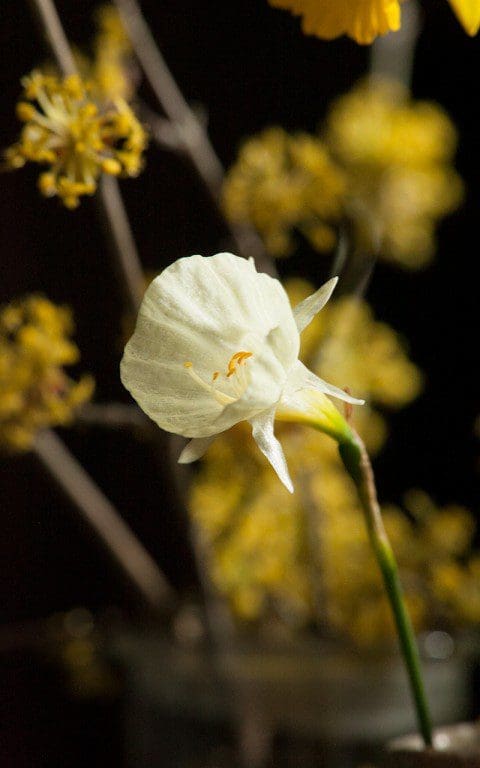 Narcissus bulbocodium ‘Spoirot’
Narcissus bulbocodium ‘Spoirot’
The very first of the Narcissus x odorus and Narcissus pallidiflorus are also out today, braving a week of overcast skies and cold rain. The N. pallidiflorus were a gift from Beth Chatto. She had been gifted them in turn by Cedric Morris, who had collected the bulbs on one of his expeditions to Europe. The flowers are a pale, primrose yellow, the trumpet slightly darker, and are distinguished by the fact that they face joyously upwards, unlike their downward-facing cousins.
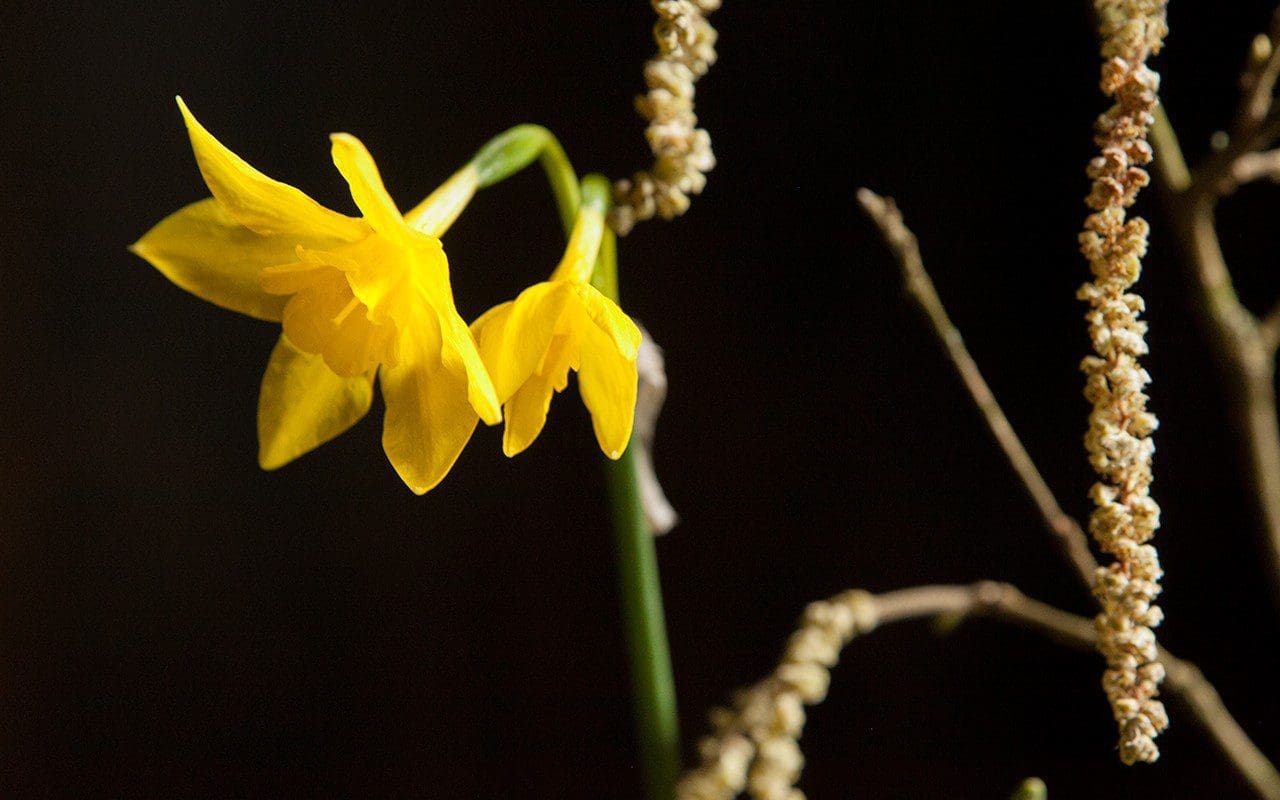 Narcissus x odorus
Narcissus x odorus
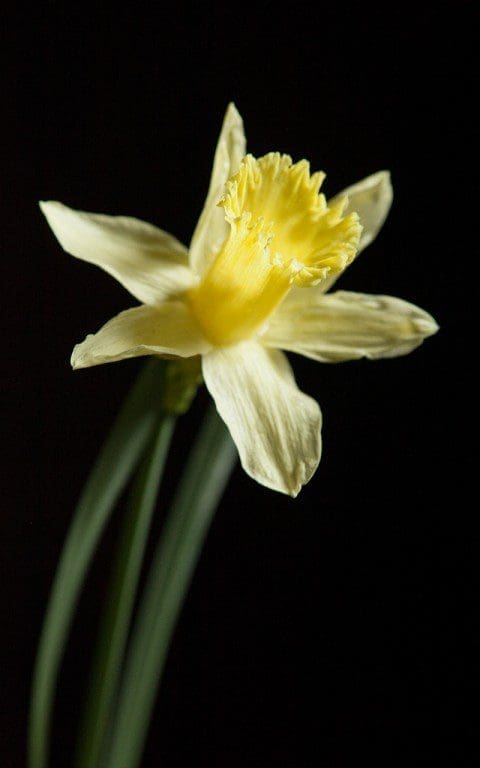 Narcissus pallidiflorus
Narcissus pallidiflorus
Our other native daffodil Narcissus pseudonarcissus has a trumpet the same gold as N. obvallaris, but with petals the pale lemon hue of N. pallidiflorus. It has an altogether lighter feeling than many of the named hybrids for this gradation of colour. We were thrilled to see a huge wild colony of them in the woods last weekend, spilling from high up on the banks, the mother colony scattering her offspring in little satellites. This is how they look best, in stops and starts and concentrations. I am slowly planting drifts along the stream edge and up through a new hazel coppice that will be useful in the future. A move that feels right for now, with all the energy and awakening of this new season.
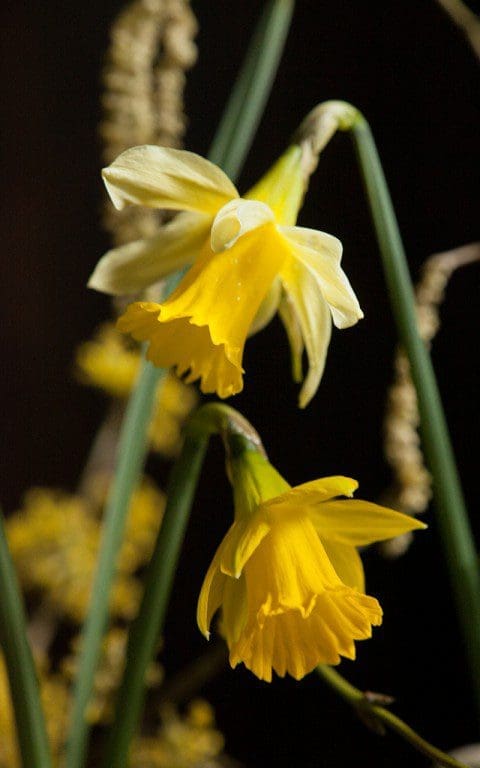 Narcissus pseudonarcissus (top), Narcissus obvallaris (bottom)
Narcissus pseudonarcissus (top), Narcissus obvallaris (bottom)
Words: Dan Pearson / Photographs: Huw Morgan
This year I have limited myself with the bulb orders as the newly landscaped ornamental garden is a year or so away from being ready for them. Bulbs are best placed where you know they can be left undisturbed so, in order for spring not to arrive without something new to look at, we have ordered a selection of tulips for cutting, a handful of Iris reticulata for pots and wild narcissus varieties to continue the ribbon that I am unravelling in stops and starts along the length of the stream at the bottom of the hill.
I started the ribbon when we first arrived, and have been adding to it every year with a couple of hundred bulbs. But that quantity of bulbs runs for just a small stretch, even if spaced in groups that smatter and appear at random among the leaf mould. So last year I grew impatient and ordered 500 and I’ve done so again this year to make the ribbon go the distance.
Our native Narcissus pseudonarcissus is most at home in open woodland where its young foliage can feast on early sunshine before the woodland canopy closes. I know them from Hampshire where they colonise hazel coppice on the lower slopes of the South Downs. Once they are established they clump densely, but the flowers rarely register as fiercely as the hosts of hybrid daffodils that you see littering parks in March. The wild daffodil is smaller in stature – just 30cm – and the flowers are fine, with twisting outer petals of pale primrose and only the trumpet a saturated gold.
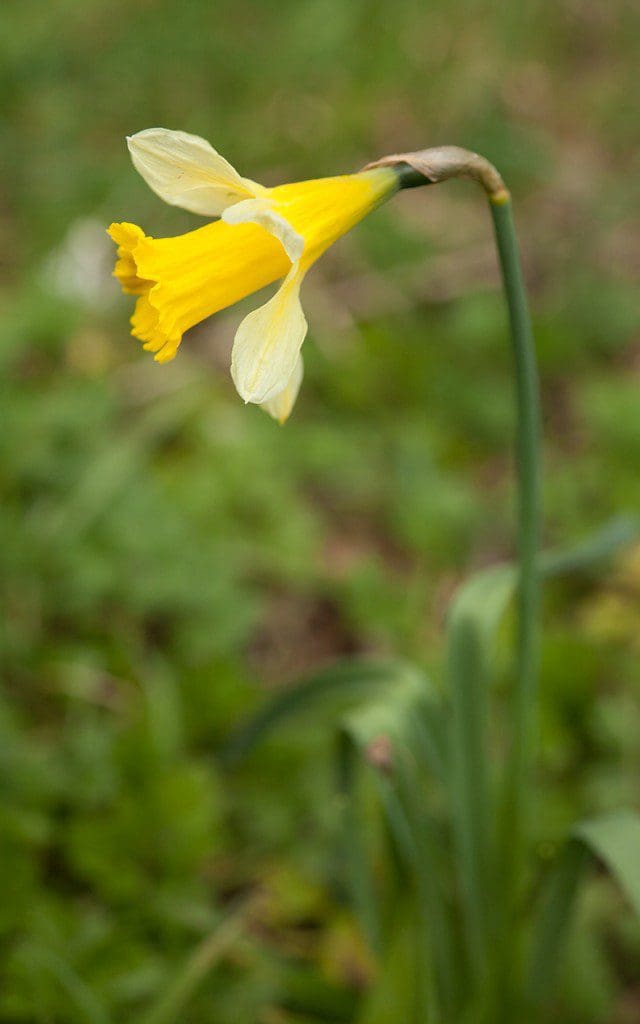 Narcissus pseudonarcissus
Narcissus pseudonarcissus
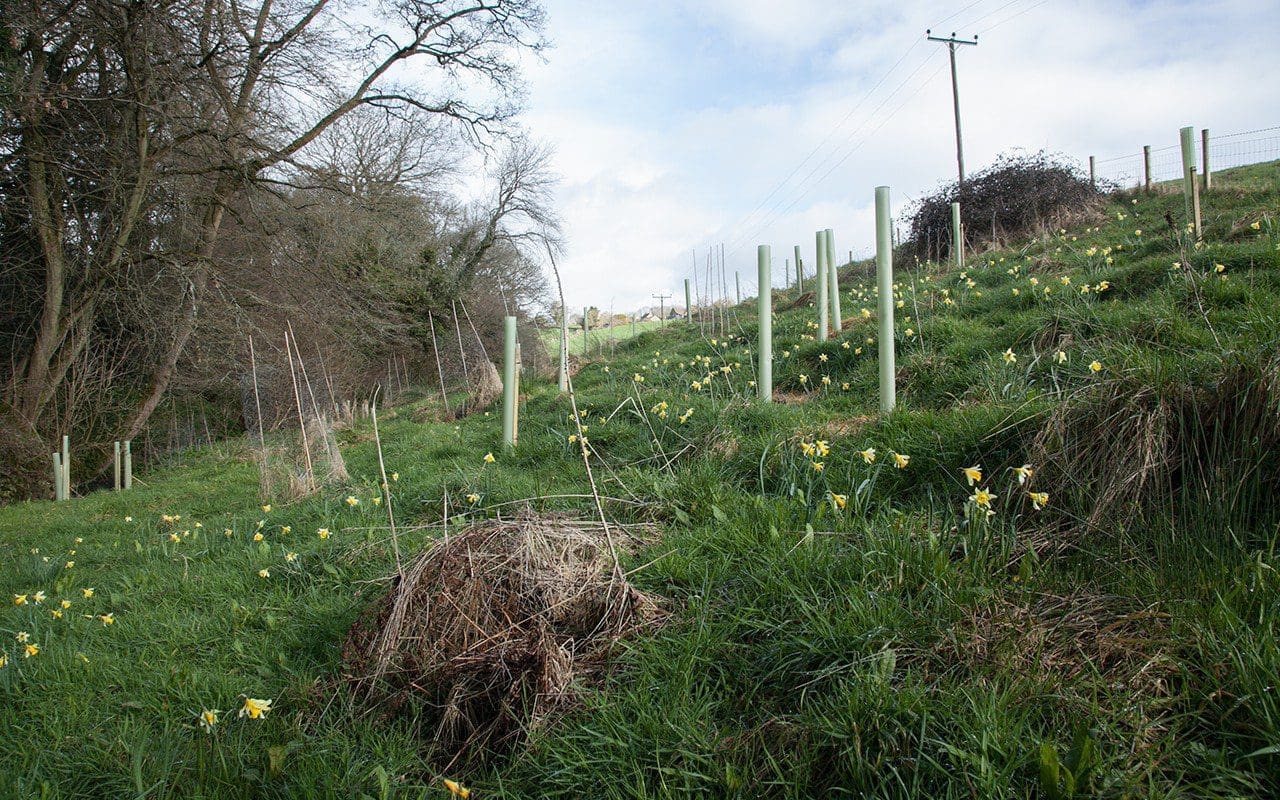 Narcissus pseudonarcissus massed under the new coppice on the lower slope of The Tump
Narcissus pseudonarcissus massed under the new coppice on the lower slope of The Tump
Unlike hybrid daffodils Narcissus pseudonarcissus is slower to establish and will often sulk for a couple of years before building up to a regular show of flower. No matter, it is worth the wait and I have already started my relay. The fourth leg runs into the area on the lower slopes of The Tump where the ground is too heavy for wild flowers and too steep for hay making and where I have taken some of the field back to plant a coppice. The hazel and hornbeam are just saplings, but it is good to think of the narcissus getting their feet in ahead of the trees.
About three years ago my parents bought me a sweet chestnut for Christmas, which I planted alone in the coppice. It will be allowed to become a standalone tree to pool shade in the future and rise up above the rhythm of the coppice as it ages. Here I have started a drift of Narcissus pseudonarcissus ssp. moschatus, the white-flowered form of the native, which has been in cultivation since the 17th century.
The elegant, downward-facing flowers are ivory as they open, fading slowly to a chalky white in all their parts. It is a beautiful thing and will be distinctive in the dim shade of the chestnut. I planted these bulbs as a memorial to my father who died the year the tree was planted and at the same time as the narcissus flower in late March. This variety is hard to find and this year I have only been able to source 50, but I am happy to add a small number annually. I like that it will take some time to come together and for the annual opportunity that this gives one to ruminate.
 Narcissus pseudonarcissus ssp. moschatus
Narcissus pseudonarcissus ssp. moschatus
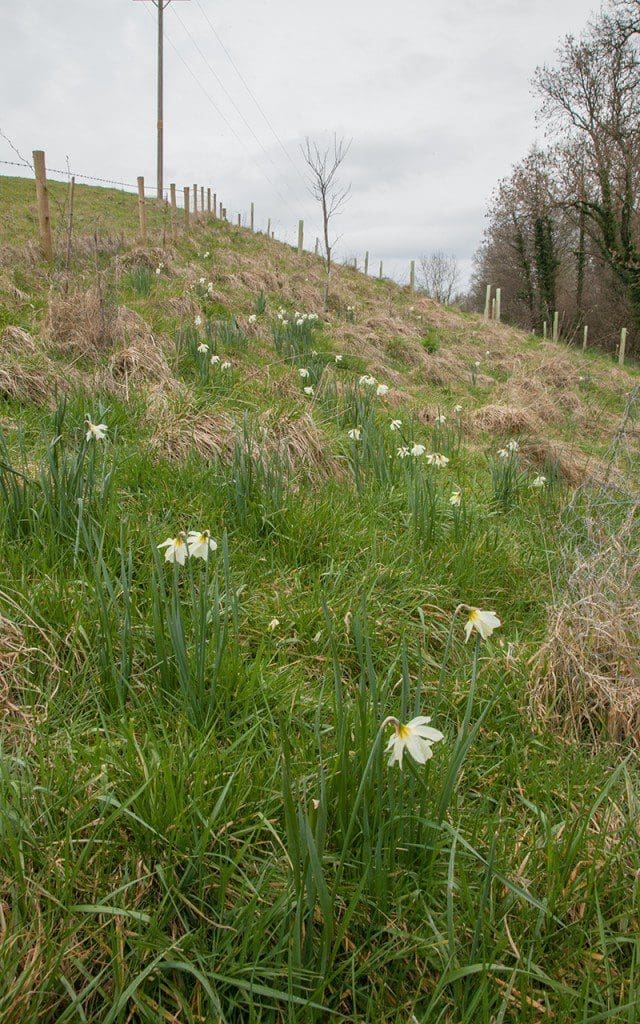 Narcissus pseudonarcissus ssp. moschatus planted around the sweet chestnut
Narcissus pseudonarcissus ssp. moschatus planted around the sweet chestnut
The Tenby Daffodil, Narcissus pseudonarcissus ssp. obvallaris, is the final part of this autumn’s order. This brighter yellow flower is also a native and, as its common name suggests, is most commonly found in Wales and the west. I have bought just a hundred and plan to trial it in the sun on the banks at the top of the brook near the beehive. Knowing your daffodils before you put them into grass is really important, as once they are in they are a nightmare to try and remove if they are wrong. I want to be confident that they aren’t too bright for their position and flare garishly where they shouldn’t. This will be my first time growing them for myself, so I want to get it right.
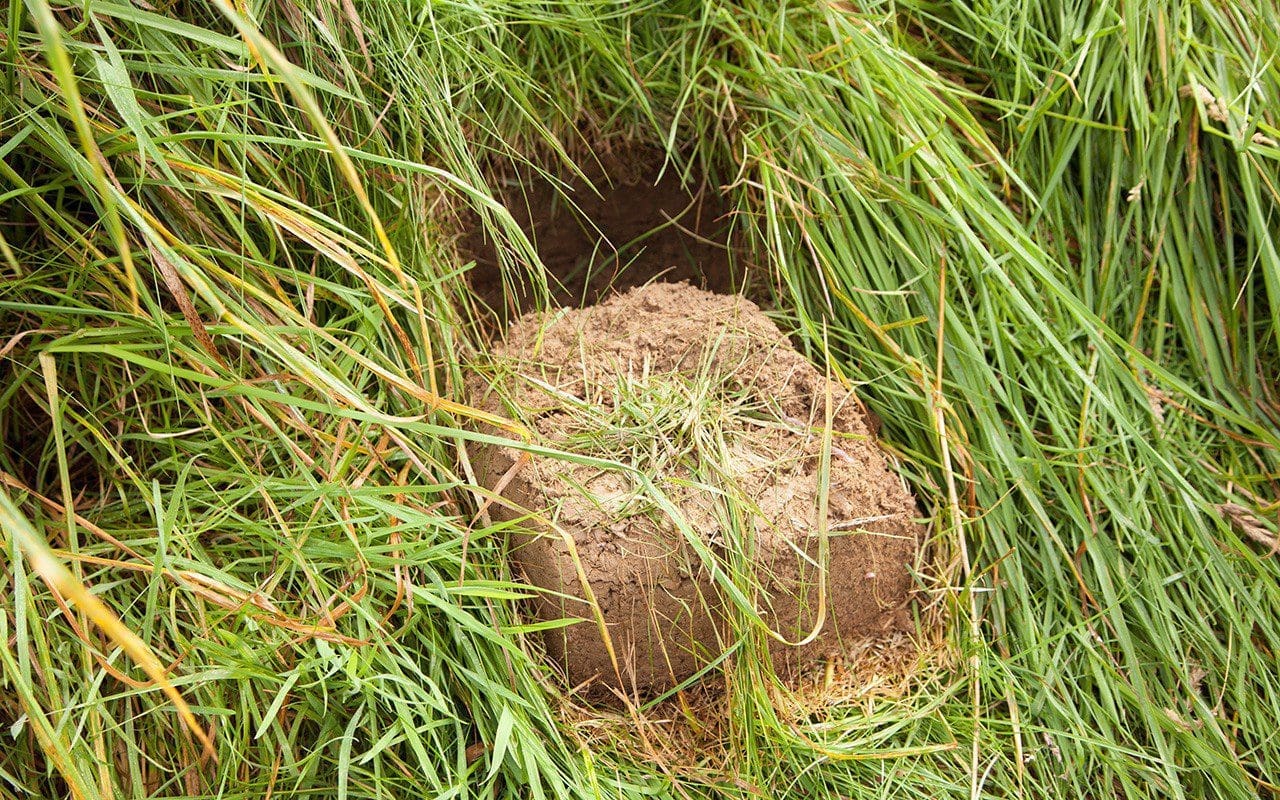 A square of lifted sod
A square of lifted sod
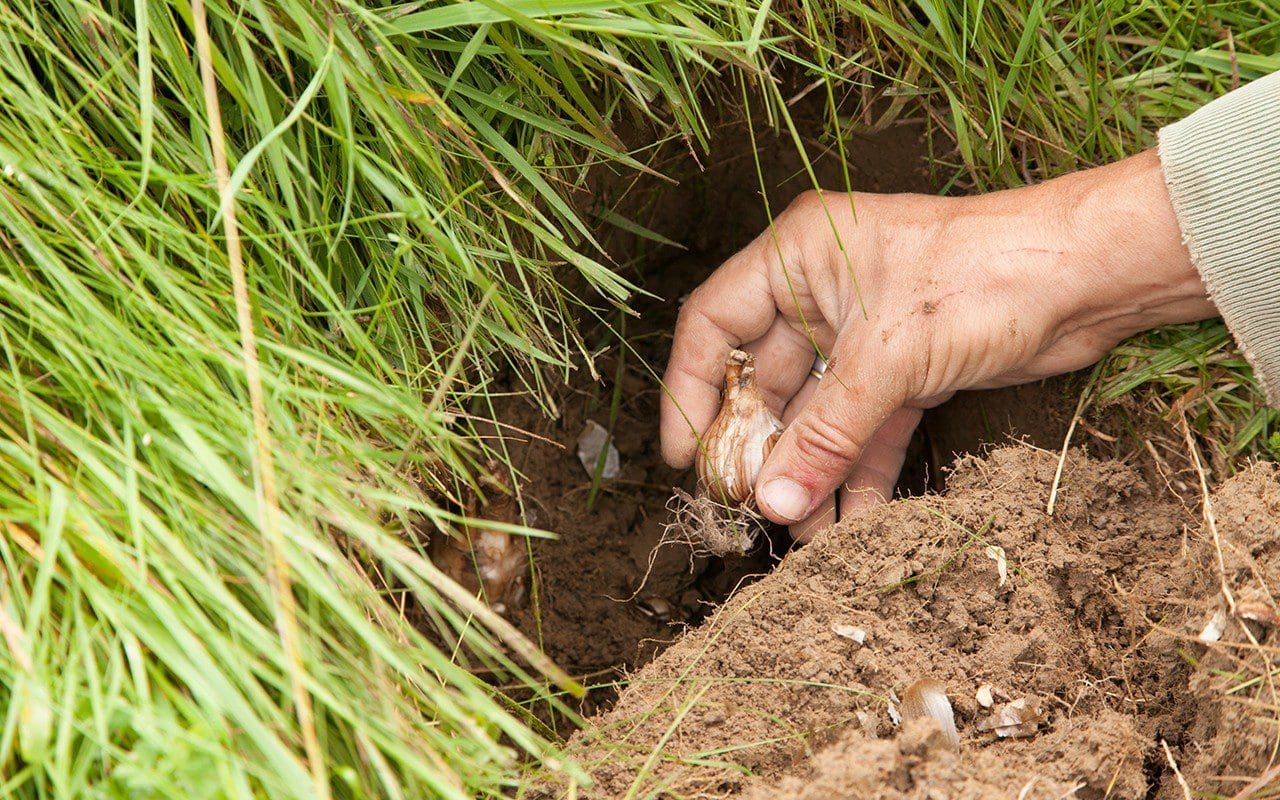 Plant the bulbs two and a half to three times the depth of the bulb
Plant the bulbs two and a half to three times the depth of the bulb
I am planting a little late this year as the wild daffodils prefer to be in the ground in August or September. They will be fine in the long run, but the green leaf tips are showing already and I can see that it would be better for them to be drawing upon new root rather than the sap of the bulb to produce this growth. To plant I lift a square sod of turf by making three slits and then levering the sod on the hinge that remains uncut. I put the bulbs in three to five per hole and at two and a half to three times the depth of the bulb. The flap is kicked back into place and firmed gently with the foot to remove any air pockets. A moment or two stepping back and imagining the same scene on the other side of winter is a very satisfying way to finish the day.
Words: Dan Pearson | Photographs: Huw Morgan
Published 8 October 2016
ALREADY A PAID SUBSCRIBER? SIGN IN